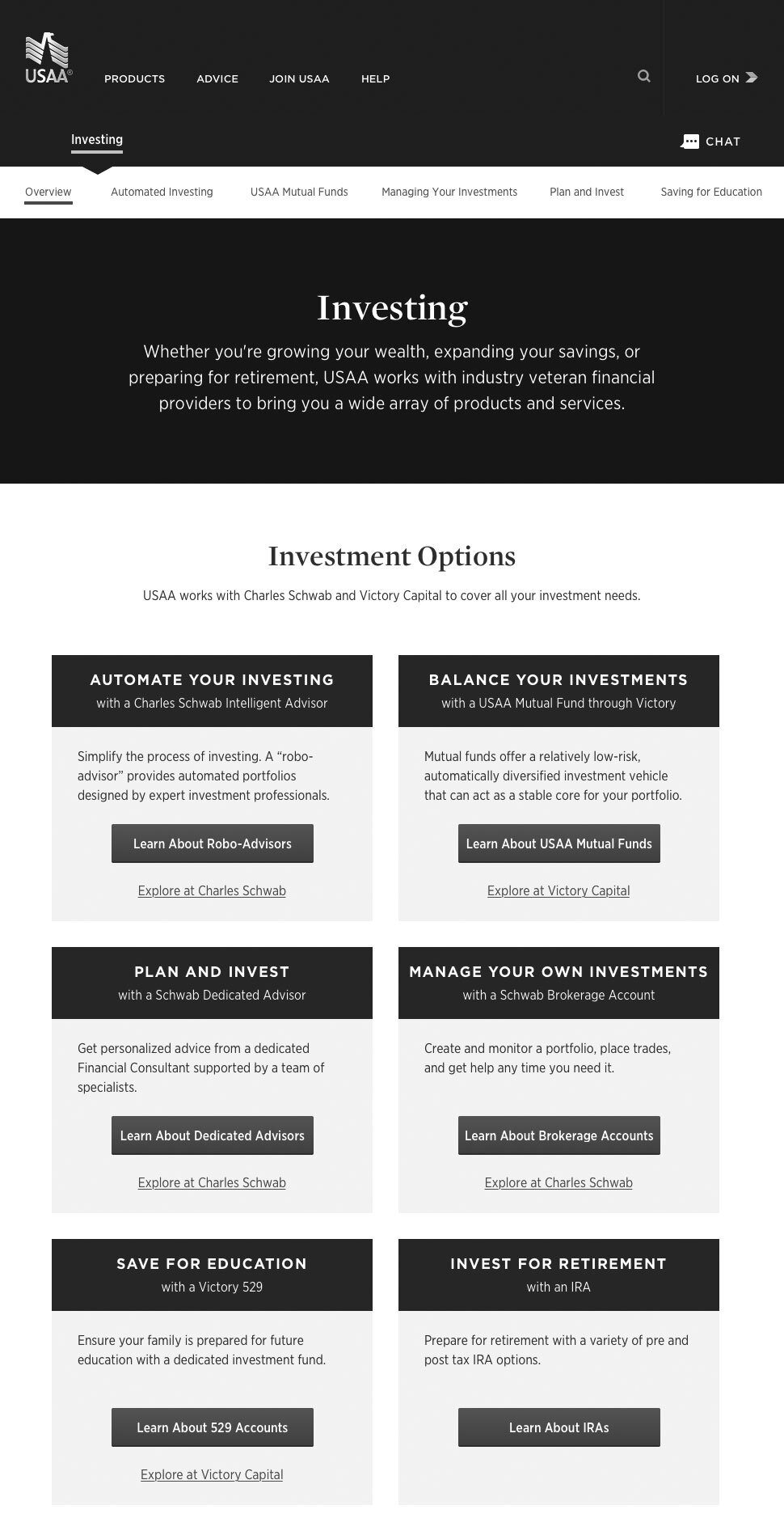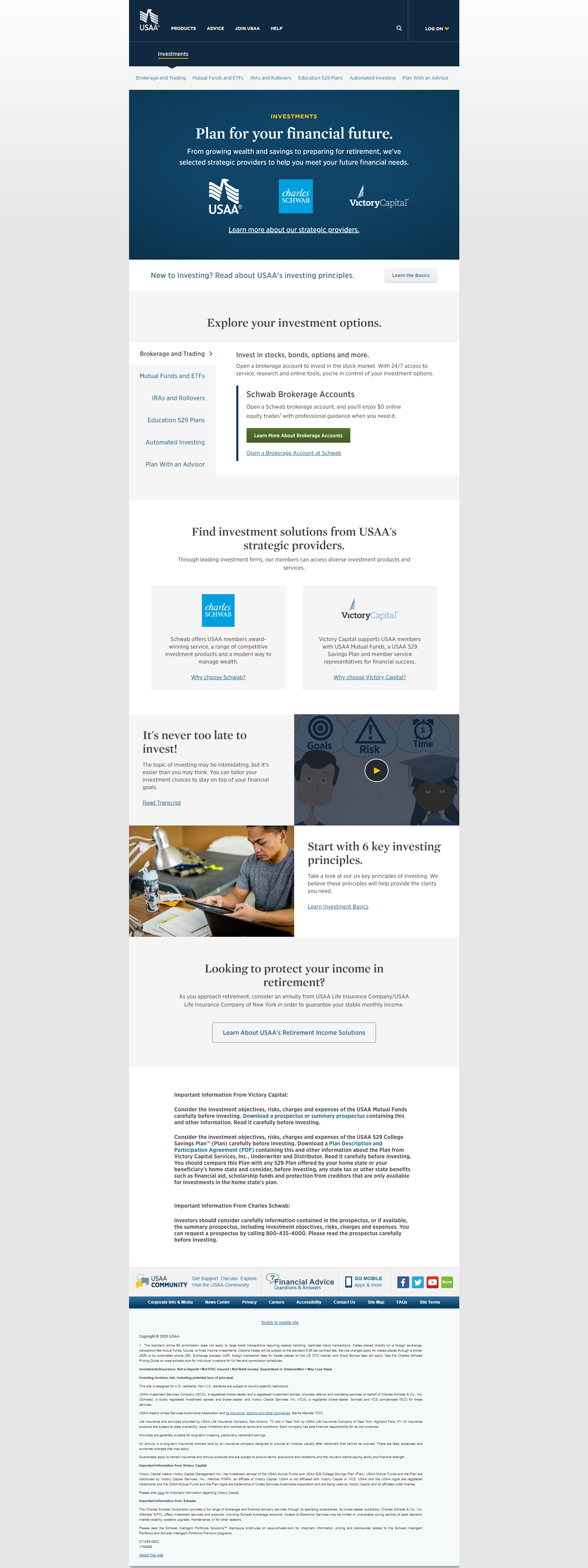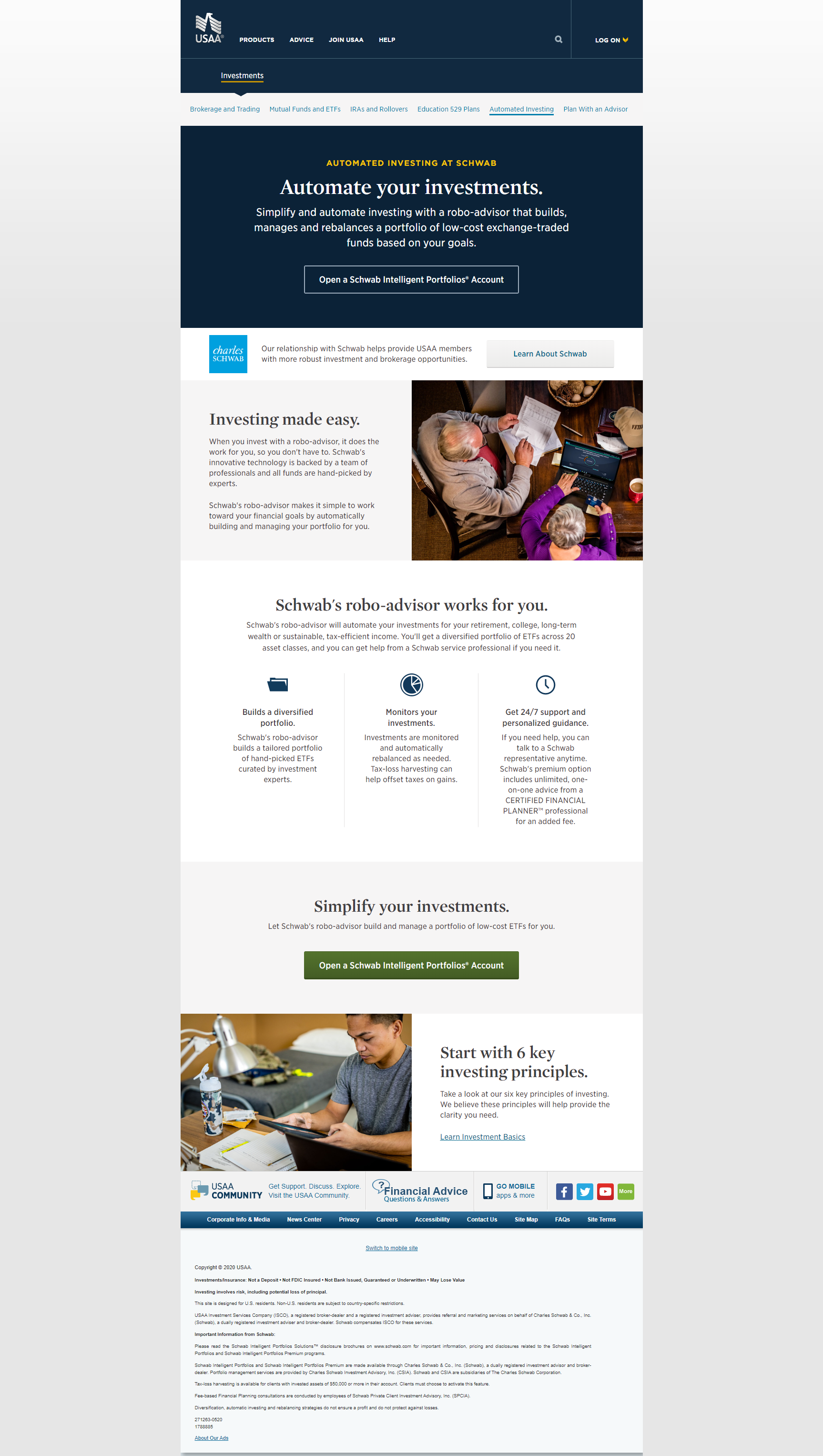USAA Investments
BACKGROUND
Client:
USAA Internal Storefront Redesign
Request:
In 2019, USAA sold off its investment portfolio to Charles Schwab and Victory Capital, Inc. This necessitated an overhaul of USAA’s business strategy as well as its web presence in order to inform members of the change in services. Our team was tasked with working with the business partners charged with the website overhaul, resulting in a new, simplified, streamlined information architecture that attempted to balance the requirements of three separate financial entities.
Challenges:
Balancing the sheer number of stakeholders involved, not just from USAA, but from Schwab and Victory Capital, Inc.
Heavily siloed environment both between business and design as well as between design and other production teams.
Business team seems inexperienced at effective requirements gathering and definition.
Extremely dated technology. The CMS used for USAA Storefront work is only marginally responsive and relies on fixed width layouts.
USAA control processes include heavy legal and compliance involvement (because it’s a financial institution) as well as intense accessibility and design guidelines.
UX Audit
I came onto the team just as the project was starting to coalesce. My first step with any redesign is almost always a UX audit of the existing site. Though the structure of the Investments portion of USAA.com would undoubtedly be entirely different due to the divestiture of the business, I still spent time exploring what would be replaced in order to understand USAA’s web design philosophy and how the organization put forth its content strategy.
Learnings from the audit:
Nearly every page within the legacy ecosystem had its own layout and approach.
Navigation often led to dead ends with no clear way to return to the root Investments page.
The navigation menu was a hierarchical mess, split into two levels that often belied the actual relationships. Some items were nested within others and others were at the same level with seemingly little rhyme or reason.
The design language applied to the legacy pages was often inconsistent and contained interactive elements that looked static and static elements that looked interactive.
Suggested strategies for the redesign:
Create page templates for pages serving similar purposes.
Ensure that users are always provided clear paths to prior areas of the site structure.
Ensure a clear hierarchy of pages and page nesting with clear relationships between parent and child content.
Apply a design language which includes consistency in use of color, layout, content strategy, and hierarchy.
Integrating with the team
Integrating with the design team was fairly straightforward, but breaking through silos between design, our business partners, our content team, and development teams proved more difficult. USAA, even by its own admission, suffers from silos resulting from decades of institutional inertia. Where other organizations have attempted to integrate production teams, USAA’s production teams still function along completely separate tracks. In order to mitigate this, we attempted to redefine the boundaries to set up the proper iteration expectations with our business partners while organizing stronger communication and hand-off procedures with our production teams.
A new Architecture
The former information architecture of the Investments structure needed a full rework, not just because of the changes to the USAA business model, but also to address hierarchical issues and needless complexity reflected in the primary, secondary, and tertiary navigation elements.
I did the initial legwork to clean up the IA as well as the navigation menu system, then worked with USAA’s IA consultation team to confirm the final structure. The result is pages nesting in a much more logical structure and a highly simplified navigation interface.
Primary Navigation Paradigm
One of our early challenges involved developing the primary navigation paradigm for the site structure. The team already had preconceptions about how the navigation should work including member need or by presenting the two providers organized with their corresponding products. I suspected that the most logical approach would be instead to present members a list of clearly labeled products, instead.
The design team strongly suggested a round of user testing based on these three paradigms. We arranged a series of general and member-based prototype tests leveraging InVision and UserZoom measure efficacy and preference.
With the data backing up the product-based approach as the most efficient and understandable navigation pattern, we were able to achieve alignment across the team as to the path forward.
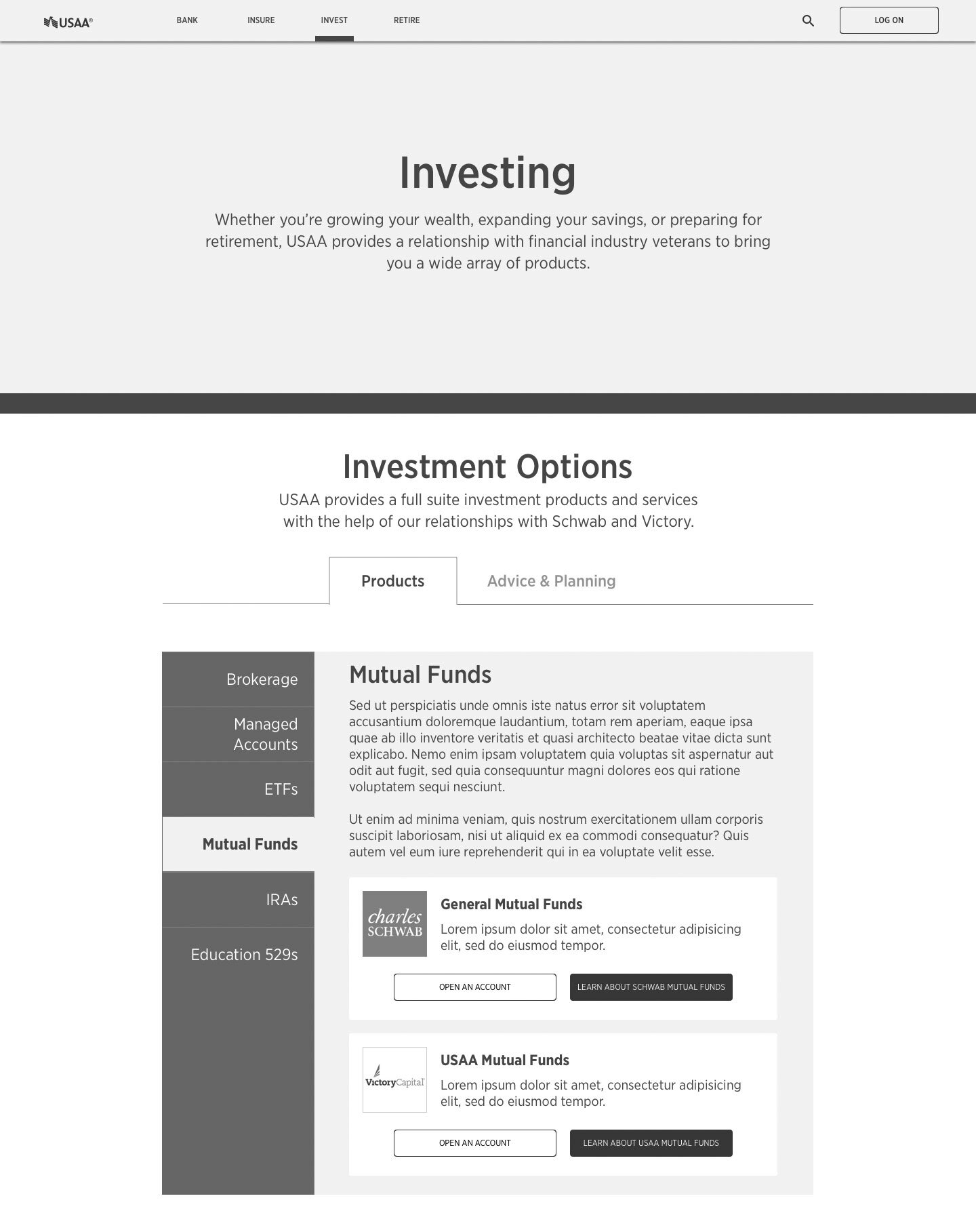
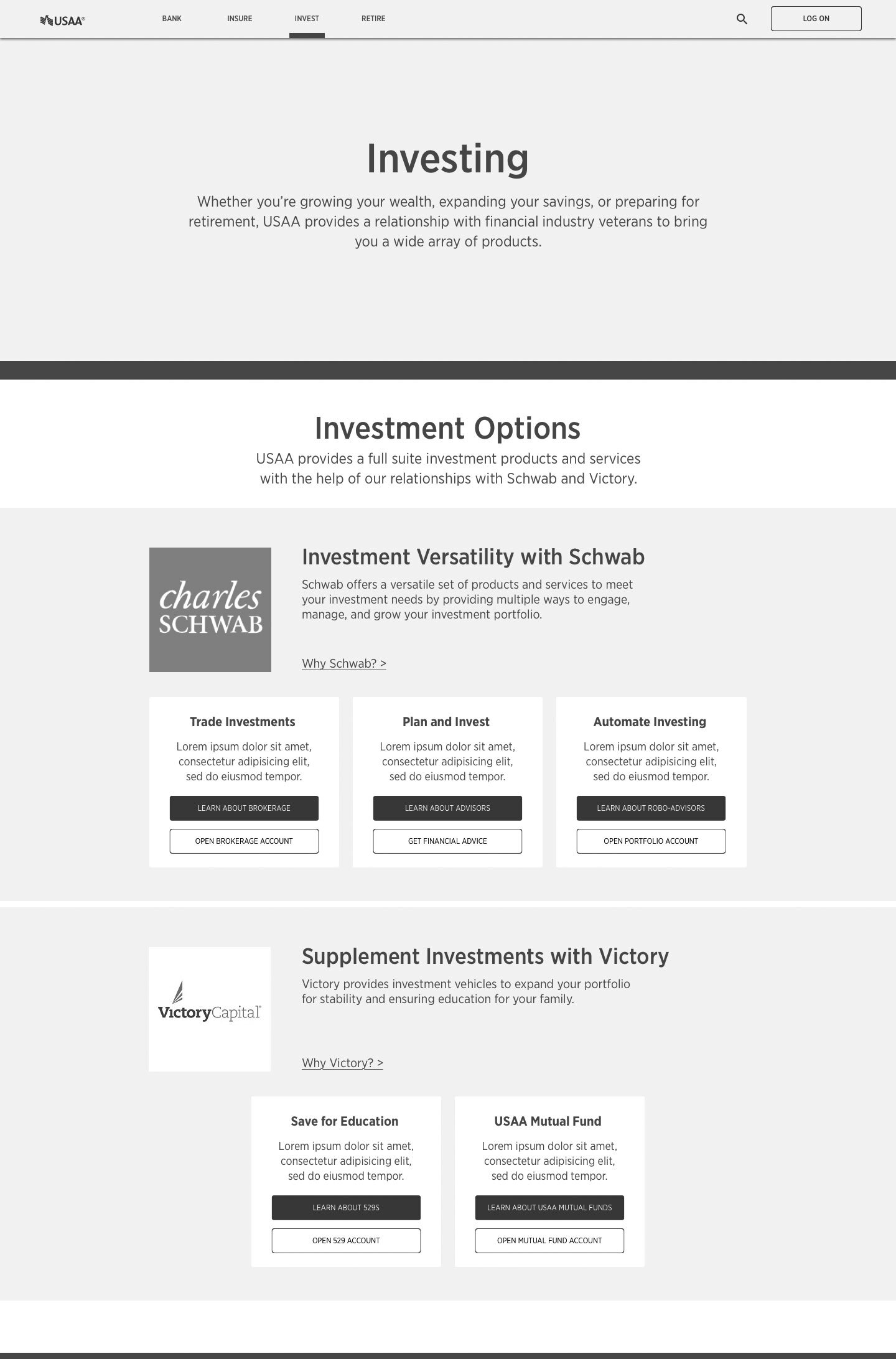
Managing Quality
My biggest surprise starting work at USAA was that no processes or tools were really in place to manage production quality. After years of using Jira in close collaboration with content and design teams in order to manage and track feedback and requirements, our team was struggling to track both internal team feedback as well as feedback from our stakeholders. Our aggressive weekly review schedule also provided little time to ensure all issues were dealt with effectively.
In order to mitigate the situation, I designed an Excel issue tracking document to take the place of Jira’s robust set of tools and adjusted my schedule to provide time for a full QA cycle prior to every release, whether for design or development. This Excel document was posted to Box and shared with our content and development partners so that they could also see feedback to be addressed within a centralized location.
Once implemented, missed issues decreased nearly to 0 upon each release and also helped us better track the status of each feature and effort, which was especially important once development started.
The launch
After scrambling through a hectic review and control process, the site launched on time with only a handful of release notes.
The launch was largely a success. The pages were intended to inform members of the impending changes to USAA in terms of the divestiture of its investments business and to guide them to the appropriate provider for specific products.
After two months, data showed about an 11.5% conversion rate of visitors heading to Schwab.com through our portal.
RESULTS
Ultimately, our team was able to deliver nearly 30 web pages on time while meeting all major requirements despite initially poor definition and shifting sands throughout the project. Along the way, we navigated the largest group of stakeholders (across three organizations) I’d ever had on a project, extremely siloed teams and processes, unclear goals and requirements, archaic technology, and overwhelmed control review teams. We survived it and succeeded by implementing developing rigor within our process and linking proverbial arms with the rest of the production team. Also key to our success was having smart, capable producers for the design team and digital production team. Currently, we are working to parse through the analytics and find further optimization opportunities within the site.
My Role: UX and Design Lead
Production Team:
Martin Davis (Director)
Benaz Meyer (Lead Producer)
Andrew Ried (Digital Project Manager)
Sinjin Hilaski (Content Writer)
Client: USAA Financial Advice and Solutions Group Internal Project
Responsibilities:
User Experience Strategy
Creative Direction
Process Design
User Testing
Requirements Documentation
UI Design



